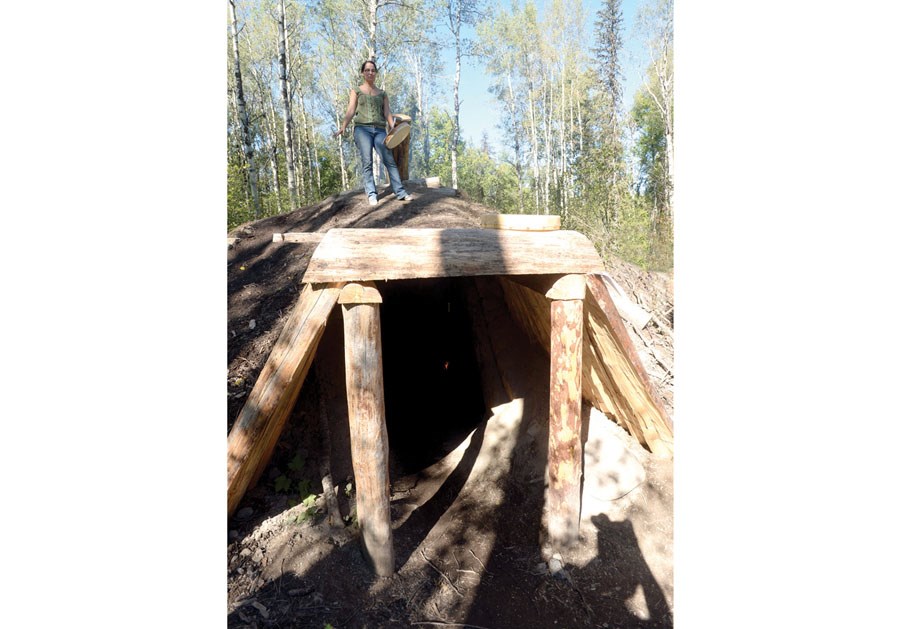UNBC and the Lheidli T'enneh First Nation officially opened a traditional Dakelh-style pit house along the Cranbrook Hill Greenway trail network near the university on Saturday.
The pit house was built between July 5 and July 25 by a group of 12 UNBC undergraduate and Lheidli T'enneh high school students and part of an experiential learning course offered through UNBC's First Nations studies program.
Vince Prince lead the team, using his experience building a pit house in Fort St. James and drawings from the journal of 19th Century missionary Father Adrien-Gabriel Morice. Not much is known about Dakelh-style pit houses, he said, although archeological evidence shows they were used in the region at least as early as the 1600s.
"They [pit houses] were the permanent winter dwellings," Prince said. "We had two drawings and two paragraphs of original information."
Traditionally, area First Nations like the Lheidli T'enneh would travel to a number of camps throughout the year, hunting, fishing and gathering, he said. They would spend the winter in their permanent winter camps in pit houses.
Pit houses have were built by a wide variety of cultures throughout the world -particularly in the Americas and northern Europe. The common feature among them is they are built over a, typically circular, pit excavated out of the ground with a wood and/or earthen roof structure.
The pit house built by the students is built on a circular pit three feet deep, with a pyramid-like wooden roof structure built over top, Prince said. The clay and topsoil excavated from the pit where then spread on top of the wooden structure, he said.
Over time, grass and other plants will grow in the soil cover to help further insulate the pit house, he said.
"In winter time, it has plenty of insulation value," he said. "Under four inches of topsoil there was no moisture. There is going to be no moisture getting to these logs."
Smoke from fires in the house's central fire pit will help dry and preserve the wood as well, he said.
"It makes it really tough," he said. "Even to cut it with a power saw... it is really, really tough. It doesn't break like normal dry pine."
Access to the pit house would traditionally be from the top only, using a log with steps carved into it, he said. But they chose to include a side entrance for ease of access, a feature found on pit houses from warmer climates to the south.
"The size of the logs is [also] way bigger than they would have used," he said. "They would have used much smaller logs - maybe four inches around."
The team used chainsaws to cut the large logs, which were on the site donated for their use, and steel hand tools like shovels and drawknives to build the house. All the digging and hauling was done by hand, he said.
The team worked six to seven hours a day for 17 days of construction to build the house, he said, with six and a half of the days used to dig the pit.
Traditionally, obsidian or flint tools were used to cut and shape the wood, Prince said. Digging sticks were used to excavate the pits, which were almost always built in gravel or sandy soil near water ways, Prince added.
Prince urged residents to come and explore the pit house, which is an approximately 15 minute walk down the main Cranbrook Hill Greenway trail from the parking lot near UNBC.
"I want to make sure people enjoy it. Come and visit it," he said.
LEARNING EXPERIENCE
Gabriella Solonas was one of the students who took part in the course and built the pit house.
Solonas, an undergraduate First Nations studies student at UNBC, said she was eager to sign up for the course after hearing about a similar class last year in which students built a traditional dugout canoe.
"The course was really awesome. It was very different than being in the classroom," Solonas said. "It was like we were building a relationship with the Lheidli... and the Lheidli territory.
It also gave her a better understanding of the resourcefulness, knowledge and skill of the Dakleh people, she said.
The bulk of the students who took part were women, she added, and the experience really showed her how strong women could be.
"I look at it like a birthing experience: we were sweating, crying and some of us bleeding," she said.
UNBC professor Antonia Mills, who developed the idea and put together the funding and support for the class, said the pit house will continue to be used for teaching.
The pit house will be used as a classroom for First Nations studies students and environmental studies, she said.
Students who took part in the class will be providing tours of the pit house as part of the university's 25th anniversary celebrations this year, she added.
"It's a very valuable learning tool," Mills said.



